Ludwig II’s Neuschwanstein remains perhaps the world’s greatest work of fan art…

Neuschwanstein project drawing, Christian Jank, 1869
From Lapham’s Quarterly:
No cars are permitted to drive the path that winds up the mountain. In fair weather, as now in late April, buses and horse-drawn carriages convey visitors up the slopes, but conditions of ice and snow close the road to all except foot traffic. Even after the shuttle drop-off point, travelers must walk the final, steepest leg of the journey through a forest of knotty-rooted firs, ferns, mosses, and toadstools. The silence is broken only by birdsong, the rustling of chaffinch or black squirrel through the underbrush, and the tramp of hikers. Like the fool Parsifal, who wanders into the mountains of the Grail knights, I marvel, “I scarcely tread, yet seem already to have come far!”
At last I see the castle, Neuschwanstein, turreted and crenellated, shining white as a swan, perched on the edge of the cliff against the backdrop of the Bavarian Alps. The building appears as though the product of centuries of reconstruction and renovation, right down to the architectural irregularities of the asymmetrical foundation and a red sandstone gatehouse that jars against the white. But Neuschwanstein, the unfinished masterpiece of Ludwig II, king of Bavaria from 1864 to 1886, was a thoroughly modern project, belonging not to medieval history but to neomedieval fairy-tale fantasy, and was built to serve a modern purpose: to manifest, relieve, and exalt Ludwig’s obsession with the works of the composer Richard Wagner. The king was perhaps the world’s greatest opera fan; his Neuschwanstein remains perhaps the world’s greatest work of fan art.
The half-hour English-language tour hustles my group up Neuschwanstein’s narrow servants’ staircase and from room to room. We learn the capsule biography of Ludwig—known as the Dream King, the Swan King, the Kitsch King, the Fairy Tale King, “Mad” King Ludwig—who ascended the throne at the age of eighteen. He became Europe’s most elusive bachelor, withdrew from court life and regal responsibilities, and spent the last two decades of his life building palaces, including Herrenchiemsee, a replica of Versailles, and Linderhof, a candy-box folly inspired by Marie Antoinette’s Petit Trianon.






